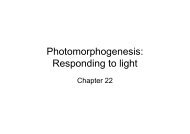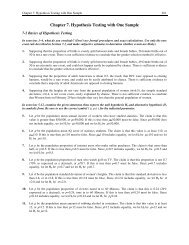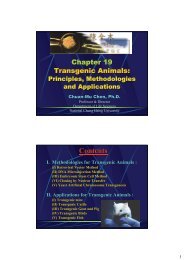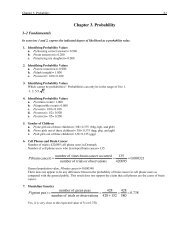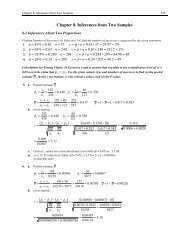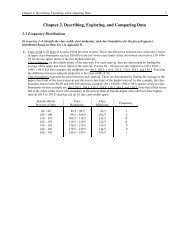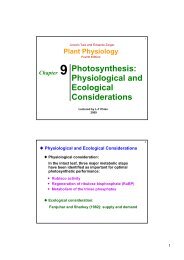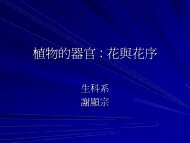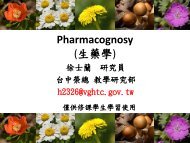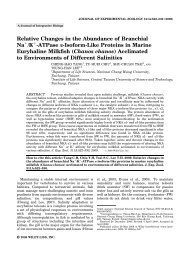Stem cells and reproduction
Stem cells and reproduction
Stem cells and reproduction
Create successful ePaper yourself
Turn your PDF publications into a flip-book with our unique Google optimized e-Paper software.
Reproductive Tract<strong>Stem</strong> <strong>cells</strong> &Implication toReproductive Medicine臺 中 榮 民 總 醫 院 婦 產 部陳 明 哲 醫 師
Introduction• ESC, iPS, Adult SC• Ovarian <strong>Stem</strong> Cell <strong>and</strong> Transplantation• Uterine <strong>Stem</strong> Cell – Endometrium, Tube• Placental <strong>Stem</strong> Cell – Amnion, A Fluid• Fetal stem cell <strong>and</strong> F-M trafficking• Reproductive Cancer SC• Conclusion
<strong>Stem</strong> <strong>cells</strong>Different SC types withdifferent characteristics withadvantages <strong>and</strong> disadvantages
• Undifferentiated <strong>cells</strong>1. Self-renewal: reproducing themselves2. Multi-lineage differentiation into manydifferent cell types3. In vivo functional reconstitution of a giventissue: producing at least one type ofhighly differentiated <strong>cells</strong>
• Embryonic stem <strong>cells</strong>1. Derived from the inner cell mass of theblastocysts2. Isolated from mouse in 1981, human in1998 -> developmental potential to formtrophoblast <strong>and</strong> derivatives of all threegerm layers in vitro.
• Research on embryonic stem <strong>cells</strong> raisesthe possibility of ‘designer’ tissue <strong>and</strong>organ engineering.
• Even if those embryos are surplus torequirements for assisted <strong>reproduction</strong><strong>and</strong> destined for destruction->Ethical considerations question theinstrumental use of embryos for theisolation of stem <strong>cells</strong>.
• One alternative is to explore the use ofadult stem <strong>cells</strong>; however, their fullpotential remains to be determined.
• Nearly all postnatal organs <strong>and</strong> tissuescontain populations of stem <strong>cells</strong>-> have the capacity for renewal afterdamage or ageing.• In the past several years, studies on adultstem cell plasticity revealed-> stem <strong>cells</strong> are able to (trans-)differentiate into other cell types in newlocations, in addition to their usual progenyin their organ of residence.
• Bone marrow derived stem cellBMCs (HSCs, MSCs) differentiate intoskeletal myoblasts, endothelium, cardiacmyoblasts, renal parenchymal, hepatic<strong>and</strong> biliary duct epithelium, lung, skin, GItracts, pancreas <strong>and</strong> CNS etc.--> BMD-SC may be involved in theregeneration of damaged tissue--> the possibility of repairing anindividual’s failing organ by BMT.
<strong>Stem</strong> cell niche
• The adult stem <strong>cells</strong> are responsible forthe growth, homeostasis <strong>and</strong> repair ofmany tissues.• How can they balance self-renewal withdifferentiation, <strong>and</strong> make the properlineage determination?
• In normal adult tissues, stem <strong>cells</strong> areultimately controlled by the integration ofintrinsic factors <strong>and</strong> extrinsic factors.(intrinsic: nuclear transcription factor)(extrinsic: cell-cell contact, growth factor,other external influence)
• Schofield (1978) proposed the stem cellniche hypothesis -> stem <strong>cells</strong> residewithin fixed compartments, or niches.1. This microenvironment, consisting ofspecialized <strong>cells</strong>, secretes signals <strong>and</strong>provides cell surface molecules2. Control the rate of stem cell proliferation,determine the fate of stem cell progeny,<strong>and</strong> protect stem <strong>cells</strong> from death.
• Mammalian stem <strong>cells</strong> niches have beendescribed in the hematopoietic, neural,epidermal, <strong>and</strong> intestinal systems.• Recent work has revealed that theinteractions between stem <strong>cells</strong> <strong>and</strong> theirniches may be more dynamic thanoriginally believed.
• For example• Hematopoietic stem <strong>cells</strong> may occupytwo anatomically <strong>and</strong> physiologicallydistinct niches,-> an osteoblast niche <strong>and</strong> a vascularniche, <strong>and</strong> shuttle between them.• The vascular niche might explain stemcell survival in extramedullaryhaematopoietic sites, such as the liver<strong>and</strong> spleen.
A. Germline stem <strong>cells</strong> in thepostnatal ovary in mammal
• Germline stem <strong>cells</strong> (GSCs)1. The self-renewing population of germ<strong>cells</strong> that serve as the source forgametogenesis.2. GSCs in Drosophila females maintainoocyte production in adult ovaries.3. Vertebrates? Mammals?
• A long-held dogma in ovarianbiology in mammals1. Females are born with a finite populationof nongrowing primordial follicles.2. Oocyte numbers decline throughoutpostnatal life, eventually leaving theovaries devoid of germ <strong>cells</strong>.3. In humans, the decline in oocytesnumbers is accompanied by exhaustionof the follicle pool <strong>and</strong> menopause beforethe end of life.
Joshua Johnson et al. providemurine evidence to challenge thisdoctrine (2004) _ MGH, Harvard
1. The numbers of healthy <strong>and</strong>degenerating follicles in ovaries ofC57BL/6 mice were counted.2. The numbers of nonatretic quiescent <strong>and</strong>early-growing prenatal follicles in singleovaries were higher than expected.3. The rate of depletion in the immatureovary was less than anticipated.
• The existence of proliferative GSCs thatgive rise to oocytes <strong>and</strong> follicleproduction in the postnatal period ofmammalian (murine) ovary.
• Bukovsky claimed to identifyGSCs <strong>and</strong> formation of newprimary follicles in adult humanovaries (2004)
1. Cytokeratin-positive mesenchymal <strong>cells</strong>in ovarian tunica albuginea differentiateinto ovarian surface epithelium (OSE)<strong>cells</strong> by a mesenchymal–epithelialtransition.2. Germ <strong>cells</strong> can originate from surfaceepithelial <strong>cells</strong> which cover the tunicaalbuginea.
• The data also indicate that the pool ofprimary follicles in adult human ovariesmay not represent a static, but rather adynamic population of differentiating <strong>and</strong>regressing structures.
• These studies1. Existence of proliferative germ <strong>cells</strong> thatsustain oocyte <strong>and</strong> follicle production inthe postnatal mammalian ovary2. Oocytes are continuously formed in theadult.3. Function of donor-derived oocytesremains to be determined
A’. Origin of germ <strong>cells</strong>in adult ovary
• The origin of oocytes in ovaries of adultmammalian females has been disputed forover 100 years.Set aside from embryonic cellIn vitro from ESCIn vitro from OSE• From BM / PB
• Weismann’s theory (In the 19thcentury)
1. Before embryonic <strong>cells</strong> becomecommitted along specific pathways, a setof germ <strong>cells</strong> is set aside, which aredestined to give rise to the gametes.2. This theory was not questioned until the1970s.
• In the early 2000s, evidence confirmedthat functional mouse oocytes <strong>and</strong> spermcan be derived from mouse embryonicstem <strong>cells</strong> in culture.
• Toyooka reported embryonic stem <strong>cells</strong>can form germ <strong>cells</strong> (participate inspermatogenesis) in vitro.
• Geijsen found that injecting these culturedhaploid male gametes into unfertilized egg ledto embryo development to the early blastocyststage.
• Hubner reported that mouse embryonicstem <strong>cells</strong> in culture can develop intooogonia that enter meiosis <strong>and</strong> recruitadjacent <strong>cells</strong> to form follicle-likestructures <strong>and</strong> later developed intoblastocysts.
• Bukovsky proposed that in adult humanfemales, the OSE was a source of germ <strong>cells</strong>.(2004)
• In 2004, this group demonstrated in vivothat new primary follicles differentiatedfrom the adult human OSE, which arisesfrom cytokeratin-positive mesenchymalprogenitor <strong>cells</strong> residing in the ovariantunica albuginea.• In 2005, in-vitro culture of human OSE<strong>cells</strong> confirmed their in-vivo observationsthat the OSE is a bipotent source ofoocytes <strong>and</strong> granulosa <strong>cells</strong>.
• Johnson (2005) reported that mammalianoocytes originate from putative germ <strong>cells</strong>in bone marrow <strong>and</strong> are distributedthrough peripheral blood to the ovaries.
• Bone marrow transplantation restoresoocyte production in wild-type micesterilized by chemotherapy, as well as inataxia telangiectasia-mutated genedeficientmice, which are otherwiseincapable of making oocytes.• Donor-derived oocytes are also observedin female mice following peripheral bloodtransplantation.
• It was suggested that bone marrow is apotential source of germ <strong>cells</strong> that couldsustain oocyte production in adulthood.
• The same group (2007) reported that bonemarrow transplantation generatesimmature oocytes <strong>and</strong> rescues long-termfertility in a preclinical mouse model ofchemotherapy-induced premature ovarianfailure.
• However, these studies are challenged bysome.• Wagers’ team established transplantation<strong>and</strong> parabiotic mouse models to assessthe capacity of circulating bone marrow<strong>cells</strong> to generate ovulated oocytes, both inthe steady state <strong>and</strong> after induced damage.
1. Their studies showed no evidence thatbone marrow <strong>cells</strong>, or any other normallycirculating <strong>cells</strong>, contribute to theformation of mature, ovulated oocytes.2. Instead, <strong>cells</strong> that travelled to the ovarythrough the bloodstream exhibitedproperties characteristic of committedblood leukocytes.
B. Ovarian tissuetransplantation
• Ovarian transplantation has a long history,traced back 200 years. However, therewas little progress until the middle of the20th century.
• Oktay <strong>and</strong> Karlikaya have reported thatovulation occurred after laparoscopictransplantation of frozen-thawed ovariantissue to the pelvic side wall in a 29-yearoldpatient who had undergone salpingooophorectomy.(NEJM, 2000)
• In 2004, the same group reported anothercase in which a four-cell embryo wasobtained from 20 oocytes retrieved fromtissue transplanted beneath the skin in apatient who had chemotherapy-inducedmenopause.
• The same year, a live birth after ovariantissue transplant was reported in anonhuman primate.
• In 2004, a successful pregnancy <strong>and</strong> livebirth after orthotopic transplantation ofcryopreserved ovarian tissue was reportedby Donnez.• In that case, a patient whose ovaries weredamaged by cancer chemotherapyreceived frozen-thawed ovarian tissuetransplantation.
• These findings give new hope for fertilitypreservation, including immature oocyteretrieval, in-vitro maturation of oocytes,oocyte vitrification or embryocryopreservation.
• However, one major concern overorthotopic auto-transplantation is thepotential risk that the frozen-thawedovarian cortex might harbor malignant<strong>cells</strong>.• There is the potential that such <strong>cells</strong> couldinduce a recurrence of disease after reimplantation.
• Silber (2005) reported that a 24-year-oldwoman gave birth after a transplant ofovarian cortical tissue from hermonozygotic twin sister.• Donnez (2007) reported another case ofsuccessful allograft of ovarian cortexbetween two genetically nonidenticalsisters.
• Silber (2007) reported 10 more successfulovary transplants in monozygotic twins afterpremature ovarian failure in one twin; twohealthy babies have been delivered, <strong>and</strong>another three pregnancies are ongoing.
• Ovarian tissue transplantation not onlybrings hope to cancer patients, but also tothose with ovarian dysgenesis orpremature ovarian failure.
C. <strong>Stem</strong> <strong>cells</strong> in the uterus
• The uterine endometrium inmammals1. One of the most dynamic human tissue.2. Consists of a gl<strong>and</strong>ular epithelium <strong>and</strong>stroma that are completely renewed ineach monthly menstrual cycle.
• Endometrial stem <strong>cells</strong>1. Thought to reside in the basalis layer2. Serve as a source of <strong>cells</strong> thatdifferentiate to form the new endometrium
• Under systemic hormonal changes, suchas the cyclic increase in the serum level ofestradiol, stem <strong>cells</strong> migrate.• Give rise to a group of progenitor <strong>cells</strong> thatbecome committed to specific types ofdifferentiated <strong>cells</strong>, for example epithelial,stromal <strong>and</strong> vascular, within a certainmicroenvironment.
• These endogenous stem <strong>cells</strong> allow therapid regeneration of the endometriumnecessary to support pregnancy.
• Two studies from different labsprovided evidence for the origin ofthis cyclic renewal (2004)Yale – TaylorMonash - Gargett
• A team led by Gargett demonstrated (2004)that human endometrium contains smallpopulations of epithelial <strong>and</strong> stromal stem<strong>cells</strong> responsible for cyclical regenerationof endometrial gl<strong>and</strong>s <strong>and</strong> stroma <strong>and</strong> thatthese <strong>cells</strong> exhibited clonogenicity.
• In 2006, Gargett’s team used labelretainingcell (LRC) approach to identifysomatic stem/progenitor <strong>cells</strong> <strong>and</strong> theirlocation.• The presence of both epithelial <strong>and</strong>stromal LRC in mouse endometrium,which suggests that these stem-like <strong>cells</strong>may be responsible for endometrialregeneration.
• In 2008, Dimitrov et al also demonstratedthat the human endometrium contains alow number of <strong>cells</strong> with the characteristicsof endometrial stromal stem/ progenitor<strong>cells</strong>, which seem to belong to the familyof the mesenchymal stem <strong>cells</strong> (MSCs).
• In 2004 Taylor et al found that bonemarrow is an exogenous source ofendometrial <strong>cells</strong>.• They provided evidence of endometrialregeneration in bone marrow transplantrecipients who received marrow from asingle-HLA antigen mismatched donorBMT for leukemia.
• Donor-derived endometrial epithelial <strong>cells</strong><strong>and</strong> stromal <strong>cells</strong> were detected inendometrial samples of bone marrowrecipients by RT-PCR <strong>and</strong>immunohistochemistry.• These <strong>cells</strong> appeared histologically to beendometrial epithelial <strong>and</strong> stromal <strong>cells</strong><strong>and</strong> also express appropriate markers ofendometrial cell differentiation.
• Taylor (2007) reported that in murinemodel after BMT, male donor-derivedbone marrow <strong>cells</strong> were found in theuterine endometrium of female mice, <strong>and</strong>,although uncommonly (
• Taylor (2007) et al also generatedexperimental endometriosis in a mousemodel by ectopic endometrial implantationin the peritoneal cavity <strong>and</strong> detected LacZexpressing <strong>cells</strong> in the wild-type ectopicendometrium after BMT from LacZtransgenic mice.• The result showed that bone marrowderived<strong>cells</strong> also contribute endometriosis.
• In 2009, a group from Japan also reported thatbone marrow-derived <strong>cells</strong> from human maledonors can compose endometrial gl<strong>and</strong>s infemale transplant recipients.
• It was suggested that1. The repopulation of endometrium withbone marrow-derived stem <strong>cells</strong> may beimportant to normal endometrialphysiology2. May help to explain the cellular basis forthe high long-term failure of conservativealternatives to hysterectomy.
• The endometrium may regenerate afterresection or ablation from a stem <strong>cells</strong>ource outside of the uterus.• These findings have potential implicationsfor the treatment of uterine disorders.• These data support a new theory for thecause of endometriosis, which may haveits origin in ectopic trans-differentiation ofstem <strong>cells</strong>.
• In 2007 two studies determined theexistence of a small population ofmultipotent stem <strong>cells</strong> in endometriumYale – TaylorMonash - Gargett
• The Gargett’s lab collected humanendometrial tissue from reproductive-agedwomen, <strong>and</strong> prepared human endometrialstromal cell cultures.• Endometrial stromal <strong>cells</strong> were incubatedwith adipogenic, osteogenic <strong>and</strong> myogenicdifferentiation induction media for 4 weeks-> a subset of endometrial stromal <strong>cells</strong>differentiate into <strong>cells</strong> of adipogenic,osteogenic, myogenic <strong>and</strong> chondrogeniccell lineages.
• Taylor’s lab also collected endometrialtissue from reproductive-aged women <strong>and</strong>monolayer endometrial stromal cell (ESC),myometrial, fibroid, fallopian tube, <strong>and</strong>uterosacral ligament tissue cultures weregenerated.
• These <strong>cells</strong> were cultured in a definedchondrogenic media containingdexamethasone <strong>and</strong> transforming growthfactor for 21 days->analyzed for markers of human articularcartilage, including sulfatedglycosaminoglycans <strong>and</strong> type II collagen.
• Cultured endometrial derived stem <strong>cells</strong>(EDSCs) contain <strong>cells</strong> that can bedifferentiated into chondrocytes.
• Taylor group has recently reported thatEDSCs can be differentiated into neuronswhich produce dopamione <strong>and</strong> have thepotential to treat Parkinson’s disease.
Thus1. Since endometrium can easily beobtained, it may represent a newpotential source of pluripotent <strong>cells</strong>.2. Endometrial biopsy could become animportant source of stem <strong>cells</strong> for futurecell-based therapies.
D. Placenta <strong>and</strong> stem <strong>cells</strong>
Placenta <strong>and</strong> Hematopoiesis• Over the last 30 years, colonization hasbeen a long accepted theory-> the yolk sac was the sole source ofhematopoiesis in the mammalian embryo.
• The embryonic yolk sac-derived HSCscolonized fetal liver to initiate definitivehematopoiesis• Subsequently colonize bone marrow at theneonatal stages to support adulthematopoiesis.
• In the 1990s, accumulating evidencelocated hematopoiesis to another site inthe aorta-gonad-mesonephros (AGM) ofmouse embryos.
• A 2003 study indicated that1. The placenta contains a high frequencyof multipotential clonogenic progenitorsincluding CFU-GMs, CFU-GEMMs, BFU-Es <strong>and</strong> HPP-CFCs.2. The study results suggestthat the placenta mayfunction as a hematopoieticorgan during development.
• In 2005, two studies simultaneouslyreported that HSCs activity can bedetected in the mid-gestation placentallabyrinth region.• The onset of HSC activity in the placentacoincides with that in the AGM region <strong>and</strong>the yolk sac.
• The expansion of the HSC pool in theplacenta occurs prior to <strong>and</strong> during theinitial expansion of HSCs in the fetal liver.• The size of the placental HSC pooldiminished, whereas the HSC pool in thefetal liver continues to exp<strong>and</strong>.
• in 2004, some groups identified <strong>and</strong>isolated <strong>cells</strong> with MSC-like potency inhuman placenta.
• In recent years, the Huang group reportedthat placenta-derived multipotent <strong>cells</strong> c<strong>and</strong>ifferentiate into hepatocyte-like <strong>cells</strong>,neuronal <strong>and</strong> glial <strong>cells</strong> when the <strong>cells</strong>cultured under appropriate conditions invitro.• The placenta may be another source ofmultipotent stem <strong>cells</strong>.
E. <strong>Stem</strong> cell transfer fromthe fetus
• The presence of fetal <strong>cells</strong> in maternalcirculation has now been confirmed bymany investigators.
• Microchimeric <strong>cells</strong> of fetal origin havebeen identified in the peripheral blood ofpatients with the autoimmune diseasesystemic sclerosis (SSc).• However, it has not been determined ifthese <strong>cells</strong> are integrally involved in thepathogenesis of SSc, or if fetalmicrochimeric <strong>cells</strong> are just a marker ofinflammation.
• Increased numbers of microchimeric fetal<strong>cells</strong> have been identified in somediseases of pregnancy, for examplepreterm labor, preeclampsia <strong>and</strong>aneuploidy.
• However, there is speculation that theincreased number of fetal microchimeric<strong>cells</strong> in the maternal circulation is areflection of the abnormalities within thestructure of the placenta, <strong>and</strong> not directlyrelated to the disease process.
• Bianchi (2001) discovered thatmale <strong>cells</strong> were seen in thyroidsections in women, presumablyfrom their sons.
• They reported that male <strong>cells</strong> were seenindividually or in clusters in all thyroiddisease from which biopsies wereexamined.• They were not restricted to inflammatorythyroid diseases.
• In one patient with a progressivelyenlarging goiter, they noted fullydifferentiated male thyroid follicles closelyattached to <strong>and</strong> indistinguishable from therest of the thyroid.
• Later on, this team reported that XY+microchimeric <strong>cells</strong> in maternal tissue,acquired most likely through pregnancy,express leukocyte, hepatocyte <strong>and</strong>epithelial markers.• The study also showed that hepatocytes offetal stem cell origin were identified in livertissue of one woman with liver injury <strong>and</strong>another woman following hepatictransplantation.
• The results suggest that pregnancy mayresult in the physiologic acquisition of afetal cell population with the capacity formultilineage differentiation.
• These findings suggest that in a state inwhich the tissue injury is chronic, fetal cellmicrochimerism may be established morefrequently, or more easily <strong>and</strong> alsosuggests that microchimeric <strong>cells</strong> areinvolved in tissue repair.
• In 2008, two groups reported interestingstudies describing the contribution of fetalstem <strong>cells</strong> to cancer.
• One group investigated microchimeric fetal<strong>cells</strong> clustered at sites of tissue injury inthe lung decades after known malepregnancy.• Male <strong>cells</strong> were identified in lung/thymustissue from all women with sons.
• The male <strong>cells</strong> in the lung were clusteredin tumors rather than in surroundinghealthy tissues.• These male presumed-fetal <strong>cells</strong> wereidentified in pathological postreproductivetissues, in which they were more likely tobe located in diseased tissues at severalfoldhigher frequency than normal tissues.
• It is suggested that fetal <strong>cells</strong> are presentat sites of tissue injury <strong>and</strong> stem <strong>cells</strong> maybe, either recruited from marrow or havingproliferated locally.
• Breast carcinomas associated withpregnancy display a high frequency ofinflammatory types, multifocal lesions <strong>and</strong>lymph node metastasis.• Another group from France questionedwhether fetal stem <strong>cells</strong> are involved inthis disease process.
• They analyzed women presenting withcarcinomas who were pregnant with malefetuses.• The results showed that the presence offetal <strong>cells</strong> in pregnancy- associated breastcarcinoma is a frequent phenomenon.• These <strong>cells</strong> were predominantly part of thetumor stroma <strong>and</strong> could contribute to thepoorer profile of these carcinomas.
F. Cancer stem <strong>cells</strong> inreproductive tract
• Cancer stem <strong>cells</strong> (CSCs)1. Rare cell population in cancer withindefinite potential for self-renewal2. They are proposed to be the cancerinitiating<strong>cells</strong> responsible fortumorigenesis <strong>and</strong> contribute to cancerresistance.3. How CSCs form? – alteration of selfrenewalpathway?
• The best known <strong>and</strong> most comparablepairs of somatic <strong>and</strong> CSCs are HSCs <strong>and</strong>leukemic stem <strong>cells</strong> (LSCs).
• Recently CSCs have been positivelyidentified <strong>and</strong> successfully isolated from alarge number of cancers.
• Ovarian cancer is an extremely aggressivedisease.• The cellular mechanisms underlying theincreasing aggressiveness associated withovarian cancer progression are poorlyunderstood.
• Epithelial ovarian cancers (EOCs) havebeen thought to arise from the simpleepithelium lining the ovarian surface orinclusion cysts-> the major subtypes of EOCs showmorphologic features that resemble thoseof the mullerian duct-derived epithelia ofthe reproductive tract.
HOX genes
1. Normally regulate mullerian ductdifferentiation, are not expressed innormal OSE2. But expressed in different EOC subtypesaccording to the pattern of mullerian-likedifferentiation of these cancers.
• Ectopic expression of Hoxa 9 intumorigenic mouse OSE <strong>cells</strong> gave rise topapillary tumors resembling serous EOCs.• In contrast, Hoxa10 <strong>and</strong> Hoxa11 inducedmorphogenesis of endometrioid- like <strong>and</strong>mucinous-like EOCs, respectively.
• Hoxa7 showed no lineage specificity, butpromoted the abilities of Hoxa9, Hoxa10,<strong>and</strong> Hoxa11 to induce differentiation alongtheir respective pathways.
• <strong>Stem</strong> cell transformation may bethe underlying mechanism leadingto ovarian cancer (2005).
• The study showed that a singletumorigenic clone was isolated among amixed population of <strong>cells</strong> derived from theascites of a patient with advanced ovariancancer.• During the course of the study, anotherclone underwent spontaneoustransformation in culture, providing amodel of disease progression.
• The tumorigenic clones, even on serialtransplantation, continue to establishtumors, thereby confirming their identity astumor stem <strong>cells</strong>.
• These findings suggest1. <strong>Stem</strong> cell transformation can be theunderlying cause of ovarian cancer.2. Progenitor cell transformation define theincreasing aggression that ischaracteristically associated with thedisease.
Side Population• Many types of stem <strong>cells</strong> use a multidrugresistance (MDR) pump to rid themselvesof chemicals, including nuclear dyes.• This property facilitates fluorescenceactivated cell sorting of those rare <strong>cells</strong>capable of nuclear dye exclusion, whichhave been termed side-population <strong>cells</strong>.• Side-population <strong>cells</strong> exhibit many stemcell-like properties
Conclusion
• We are just beginning to underst<strong>and</strong> stem<strong>cells</strong>, <strong>and</strong> many key questions remain.• <strong>Stem</strong> <strong>cells</strong> may play an important role innormal uterine <strong>and</strong> ovarian physiology.• They likely are involved in the response ofthese tissues to injury <strong>and</strong> disease.
• <strong>Stem</strong> <strong>cells</strong> likely play a role in pathology ofthe reproductive tract. <strong>Stem</strong> <strong>cells</strong> give riseto cancers <strong>and</strong> endometriosis.• A better underst<strong>and</strong>ing of stem cell biologymay prove helpful in the treatment of theseconditions.
• Finally the fetus, placenta <strong>and</strong> even theendometrium are all sources of stem <strong>cells</strong>.• Endometrial-derived stem <strong>cells</strong> mayprovide an immunologically matchedsource of multipotent stem <strong>cells</strong> for tissueengineering <strong>and</strong> regenerative medicine.




